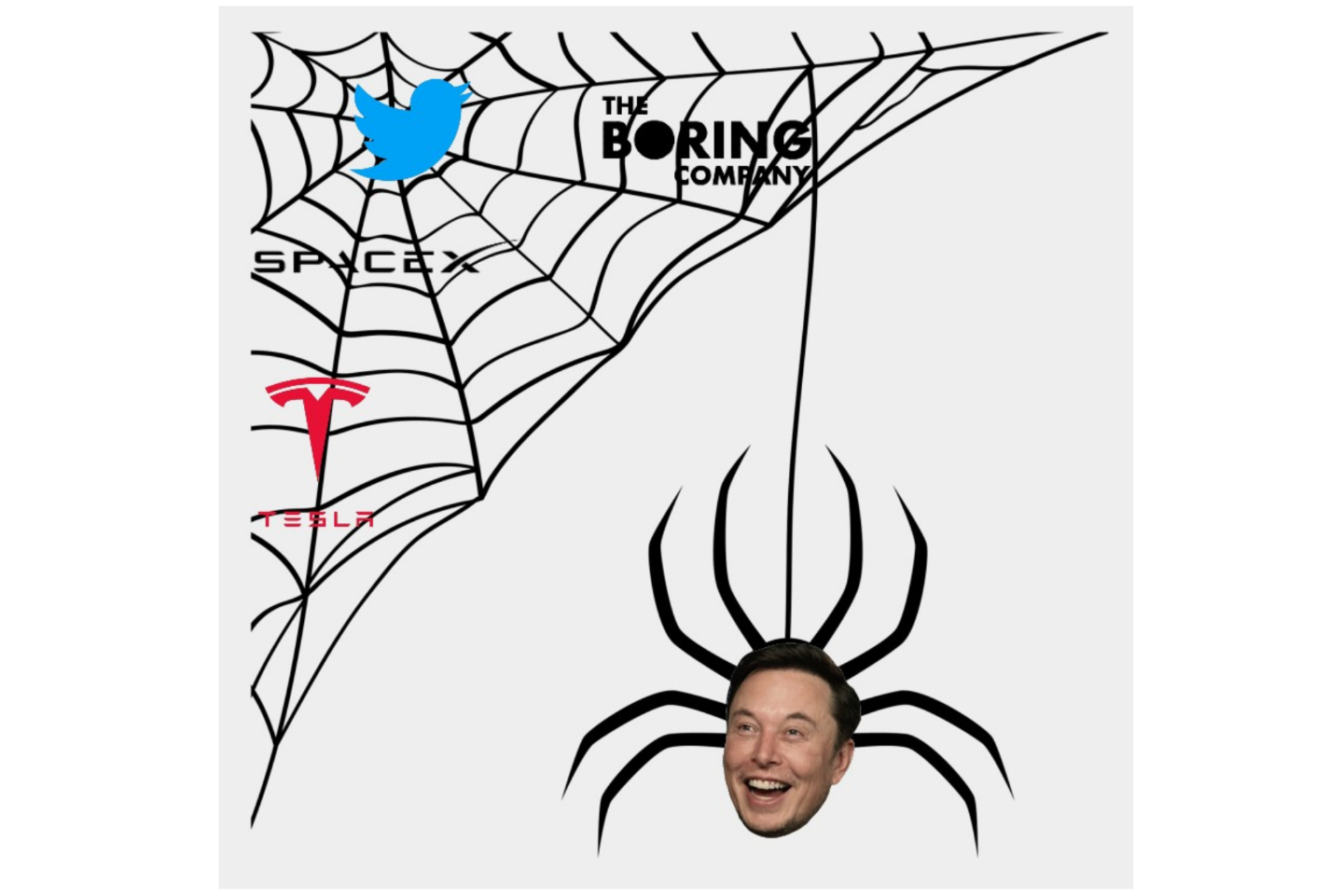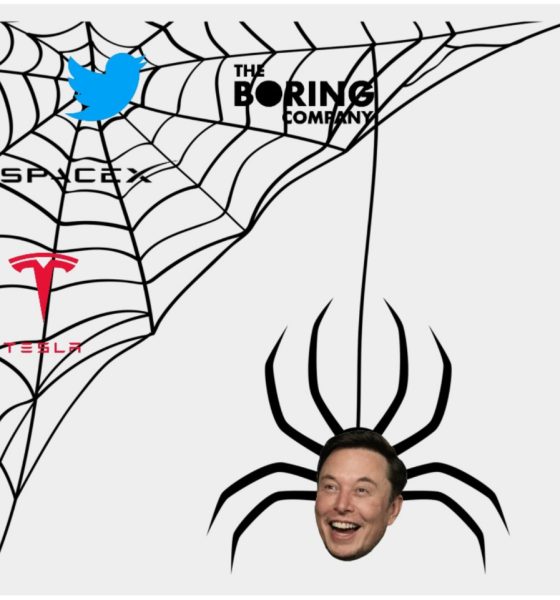

News
In Elon Musk’s intertwining web of companies, Twitter is the latest addition
Elon Musk recently added Twitter to the list of companies he currently controls. Tesla, SpaceX, the Boring Company, and others have all worked as an intertwining web of entities with Musk acting as the spider. With the addition of Twitter, Musk adds another dimension to his list of companies that work with one another, all of which will ultimately culminate in the creation of X, a parent company.
While Musk’s ownership and control of Twitter are less than two weeks from its beginnings, employees of the social media network are learning a new lesson: just because it does not deal with cars, rockets, or tunnels, doesn’t mean those will not somehow come into the picture later on.
Twitter engineers learned this lesson faster than anyone as reports circulated late last week that Tesla employees were heading to downtown San Francisco to work side-by-side with the social media platform’s software people. The move was met with mixed reviews: some literally could not care less, but others felt Tesla engineers already had enough on their plate. After all, Musk said earlier this year he’d be very surprised if Tesla did not solve its Full Self-Driving suite by year’s end, and less than two months remain in 2022.
For anyone seasoned with Musk and his many ventures, the move was not all that much of a surprise. The Tesla CEO’s companies have never been wholly individualized, per se. While Tesla builds cars, SpaceX builds rockets, and the Boring Company builds underground tunnels, the three companies all have a little piece of each other. It’s more than likely just an advantage of having your hands in a lot of different buckets.
Take Tesla and SpaceX for example. The Model X drove NASA astronauts Doug Hurley and Bob Behnken to the launchpad for the SpaceX Demo-2 launch last year. Tesla has used SpaceX welding techniques to improve the strength of aluminum parts in the Model Y. According to CNBC, Tesla sold SpaceX $2 million worth of vehicle components in Q1 2021.
NASA shows off Tesla Model X astronaut transport vehicle ahead of historic launch
Tesla and the Boring Company have an obvious connection due to the latter’s use of the former’s vehicles within its tunnels. Most notably, the Vegas Loop, which aims to revolutionize commuter and tourist travel in the Sin City, utilizes an array of Tesla vehicles to improve its express-style travel, helping to accommodate for groups of all sizes.
One of the advantages of having so many different companies in so many different industries is that eventually, situations will arise that may hint toward a conjuctive effort to solve a problem. Twitter is no different. A company that has obvious struggles in its DNA, evident through its battle with bots and spam accounts, Twitter is getting attention from some highly talented engineers at Tesla.
There are criticisms, too. Of course, Tesla investors may not love hearing that company employees are devoting time to a project that many of them disagreed with, to begin with. It is no secret that some of Musk’s biggest supporters have questioned the Twitter saga, referring to it as a distraction or a mistake. Musk, on the other hand, believes Twitter’s status as a modern-day town hall that highlights free speech is essential, and it is just one more thing he saw that he felt needed fixing.
For what it is worth, the workload and daily calendar Musk keeps is pretty impressive. A string of companies all helping one another is also a big plus and a huge advantage.
I’d love to hear from you! If you have any comments, concerns, or questions, please email me at joey@teslarati.com. You can also reach me on Twitter @KlenderJoey, or if you have news tips, you can email us at tips@teslarati.com.

Elon Musk
Elon Musk and Tesla AI Director share insights after empty driver seat Robotaxi rides
The executives’ unoccupied tests hint at the rapid progress of Tesla’s unsupervised Robotaxi efforts.

Tesla CEO Elon Musk and AI Director Ashok Elluswamy celebrated Christmas Eve by sharing personal experiences with Robotaxi vehicles that had no safety monitor or occupant in the driver’s seat. Musk described the system’s “perfect driving” around Austin, while Elluswamy posted video from the back seat, calling it “an amazing experience.”
The executives’ unoccupied tests hint at the rapid progress of Tesla’s unsupervised Robotaxi efforts.
Elon and Ashok’s firsthand Robotaxi insights
Prior to Musk and the Tesla AI Director’s posts, sightings of unmanned Teslas navigating public roads were widely shared on social media. One such vehicle was spotted in Austin, Texas, which Elon Musk acknowleged by stating that “Testing is underway with no occupants in the car.”
Based on his Christmas Eve post, Musk seemed to have tested an unmanned Tesla himself. “A Tesla with no safety monitor in the car and me sitting in the passenger seat took me all around Austin on Sunday with perfect driving,” Musk wrote in his post.
Elluswamy responded with a 2-minute video showing himself in the rear of an unmanned Tesla. The video featured the vehicle’s empty front seats, as well as its smooth handling through real-world traffic. He captioned his video with the words, “It’s an amazing experience!”
Towards Unsupervised operations
During an xAI Hackathon earlier this month, Elon Musk mentioned that Tesla owed be removing Safety Monitors from its Robotaxis in Austin in just three weeks. “Unsupervised is pretty much solved at this point. So there will be Tesla Robotaxis operating in Austin with no one in them. Not even anyone in the passenger seat in about three weeks,” he said. Musk echoed similar estimates at the 2025 Annual Shareholder Meeting and the Q3 2025 earnings call.
Considering the insights that were posted Musk and Elluswamy, it does appear that Tesla is working hard towards operating its Robotaxis with no safety monitors. This is quite impressive considering that the service was launched just earlier this year.
Elon Musk
Starlink passes 9 million active customers just weeks after hitting 8 million
The milestone highlights the accelerating growth of Starlink, which has now been adding over 20,000 new users per day.

SpaceX’s Starlink satellite internet service has continued its rapid global expansion, surpassing 9 million active customers just weeks after crossing the 8 million mark.
The milestone highlights the accelerating growth of Starlink, which has now been adding over 20,000 new users per day.
9 million customers
In a post on X, SpaceX stated that Starlink now serves over 9 million active users across 155 countries, territories, and markets. The company reached 8 million customers in early November, meaning it added roughly 1 million subscribers in under seven weeks, or about 21,275 new users on average per day.
“Starlink is connecting more than 9M active customers with high-speed internet across 155 countries, territories, and many other markets,” Starlink wrote in a post on its official X account. SpaceX President Gwynne Shotwell also celebrated the milestone on X. “A huge thank you to all of our customers and congrats to the Starlink team for such an incredible product,” she wrote.
That growth rate reflects both rising demand for broadband in underserved regions and Starlink’s expanding satellite constellation, which now includes more than 9,000 low-Earth-orbit satellites designed to deliver high-speed, low-latency internet worldwide.
Starlink’s momentum
Starlink’s momentum has been building up. SpaceX reported 4.6 million Starlink customers in December 2024, followed by 7 million by August 2025, and 8 million customers in November. Independent data also suggests Starlink usage is rising sharply, with Cloudflare reporting that global web traffic from Starlink users more than doubled in 2025, as noted in an Insider report.
Starlink’s momentum is increasingly tied to SpaceX’s broader financial outlook. Elon Musk has said the satellite network is “by far” the company’s largest revenue driver, and reports suggest SpaceX may be positioning itself for an initial public offering as soon as next year, with valuations estimated as high as $1.5 trillion. Musk has also suggested in the past that Starlink could have its own IPO in the future.
News
NVIDIA Director of Robotics: Tesla FSD v14 is the first AI to pass the “Physical Turing Test”
After testing FSD v14, Fan stated that his experience with FSD felt magical at first, but it soon started to feel like a routine.

NVIDIA Director of Robotics Jim Fan has praised Tesla’s Full Self-Driving (Supervised) v14 as the first AI to pass what he described as a “Physical Turing Test.”
After testing FSD v14, Fan stated that his experience with FSD felt magical at first, but it soon started to feel like a routine. And just like smartphones today, removing it now would “actively hurt.”
Jim Fan’s hands-on FSD v14 impressions
Fan, a leading researcher in embodied AI who is currently solving Physical AI at NVIDIA and spearheading the company’s Project GR00T initiative, noted that he actually was late to the Tesla game. He was, however, one of the first to try out FSD v14.
“I was very late to own a Tesla but among the earliest to try out FSD v14. It’s perhaps the first time I experience an AI that passes the Physical Turing Test: after a long day at work, you press a button, lay back, and couldn’t tell if a neural net or a human drove you home,” Fan wrote in a post on X.
Fan added: “Despite knowing exactly how robot learning works, I still find it magical watching the steering wheel turn by itself. First it feels surreal, next it becomes routine. Then, like the smartphone, taking it away actively hurts. This is how humanity gets rewired and glued to god-like technologies.”
The Physical Turing Test
The original Turing Test was conceived by Alan Turing in 1950, and it was aimed at determining if a machine could exhibit behavior that is equivalent to or indistinguishable from a human. By focusing on text-based conversations, the original Turing Test set a high bar for natural language processing and machine learning.
This test has been passed by today’s large language models. However, the capability to converse in a humanlike manner is a completely different challenge from performing real-world problem-solving or physical interactions. Thus, Fan introduced the Physical Turing Test, which challenges AI systems to demonstrate intelligence through physical actions.
Based on Fan’s comments, Tesla has demonstrated these intelligent physical actions with FSD v14. Elon Musk agreed with the NVIDIA executive, stating in a post on X that with FSD v14, “you can sense the sentience maturing.” Musk also praised Tesla AI, calling it the best “real-world AI” today.








